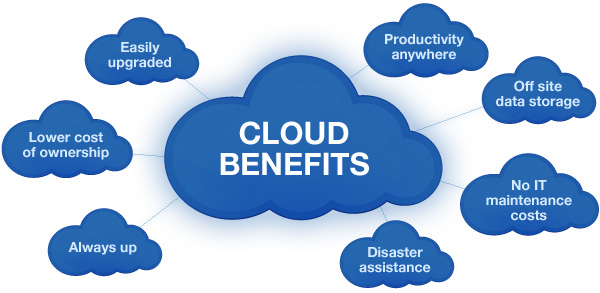Advantage of Cloud Computing and Explain Its Concept
Advantage of Cloud Computing has become an integral part of the modern digital landscape, pan cost-efficiency, scalability, and more.

Advantage of Cloud Computing has become ubiquitous, transforming the way individuals and businesses operate and interact with technology.
From storing photos and videos on the cloud to running complex algorithms for business analytics, cloud computing has revolutionized the IT landscape.
In this blog post, we will delve deep into the concept of cloud computing and explore its myriad advantages.
Understanding the Advantage of Cloud Computing
At its core, cloud computing refers to the delivery of computing services such as servers, storage, databases, networking, software, analytics, and intelligence over the internet.
Unlike traditional computing methods that rely on local servers or personal computers to handle applications, cloud computing leverages remote servers hosted on the internet to store, manage, and process data.
This shift to the cloud offers numerous benefits that have reshaped the way we approach technology.
The Advantages of Cloud Computing
Cost-Efficiency:
One of the most compelling advantages of cloud computing is its cost-efficiency. Traditional IT infrastructure often requires significant upfront investments in hardware and software.
In contrast, cloud services are typically provided on a pay-as-you-go or subscription-based model. This means businesses only pay for the resources they actually use, reducing capital expenditures and operational costs.
Scalability:
Scalability is a fundamental feature of cloud computing. Businesses can easily scale up or down their computing resources based on demand. This flexibility allows organizations to respond quickly to changing workloads, ensuring optimal performance without overprovisioning or underutilizing resources.
Accessibility:
Cloud computing services are accessible from anywhere with an internet connection. This accessibility fosters collaboration among remote teams and facilitates remote work arrangements, which have become increasingly important in today's globalized and digitalized world.
Reliability and Redundancy:
Cloud service providers invest heavily in infrastructure and security, ensuring high availability and data redundancy. This means that data and applications hosted in the cloud are often more reliable than on-premises solutions. In case of hardware failures or disasters, cloud providers have backup systems in place to minimize downtime.
Security:
While security concerns have been a point of contention, cloud providers have significantly improved their security measures over the years. Many of them offer robust encryption, identity and access management, and compliance certifications. Moreover, they often have dedicated teams focused on monitoring and responding to security threats.
Automatic Updates:
Cloud service providers take care of infrastructure maintenance, including software updates and security patches. This relieves businesses of the burden of managing these tasks, allowing them to focus on their core operations.
Global Reach:
Cloud computing enables organizations to expand their global reach without the need for physical infrastructure in different locations. With data centers strategically positioned around the world, cloud providers offer low-latency access to resources and services for users in various regions.
Environmentally Friendly:
Cloud computing can be more environmentally friendly than traditional on-premises data centers. Cloud providers optimize resource utilization, reducing energy consumption and carbon footprints. Additionally, they often invest in renewable energy sources to power their data centers.
Data Backup and Recovery:
Cloud services offer robust data backup and recovery solutions. In the event of data loss due to accidents or cyberattacks, businesses can quickly restore their data from backups, minimizing downtime and data loss.
Innovation and Agility:
Cloud computing fosters innovation and agility by providing access to a vast ecosystem of services, tools, and technologies. Developers can quickly experiment, prototype, and deploy new applications and services, accelerating time-to-market.
Competitive Edge:
Leveraging cloud technologies can provide a competitive edge. Businesses that adopt cloud computing can adapt to market changes more swiftly, optimize operations, and innovate in ways that can set them apart from competitors.
Types of Cloud Computing Services
To better understand the advantages of cloud computing, it's important to recognize the various types of cloud services available:
Infrastructure as a Service (IaaS): IaaS provides virtualized computing resources over the internet, including virtual machines, storage, and networking. Users can manage and control the operating system, applications, and data.
Platform as a Service (PaaS): PaaS offers a platform that allows developers to build, deploy, and manage applications without worrying about the underlying infrastructure. It provides tools, libraries, and services to streamline the development process.
Software as a Service (SaaS): SaaS delivers software applications over the internet on a subscription basis. Users can access these applications through a web browser, eliminating the need for local installations and updates.
Function as a Service (FaaS): FaaS, also known as serverless computing, allows developers to execute individual functions or pieces of code in response to events or triggers. Developers are billed only for the compute resources consumed during execution.
Real-World Applications of Cloud Computing
The versatility of cloud computing has led to its widespread adoption across various industries and applications:
1. Business and Enterprise Solutions:
Cloud-based applications such as customer relationship management (CRM) systems, enterprise resource planning (ERP) software, and collaboration tools have become essential for businesses to streamline operations and enhance productivity.
2. E-Commerce:
Online retailers leverage cloud computing to handle peak traffic during sales events, store customer data securely, and offer personalized shopping experiences.
3. Healthcare:
Cloud computing facilitates the storage and analysis of large volumes of medical data, enabling healthcare providers to improve patient care, conduct medical research, and enhance diagnostic capabilities.
4. Education:
Cloud-based learning management systems (LMS) and virtual classrooms have transformed education by providing accessible and flexible learning environments for students of all ages.
5. Entertainment:
Streaming platforms, gaming services, and digital content providers rely on cloud infrastructure to deliver seamless and high-quality experiences to users worldwide.
6. Internet of Things (IoT):
Cloud computing supports IoT devices by collecting, processing, and analyzing data generated by sensors and devices, enabling smart homes, cities, and industries.
7. Research and Development:
Scientists and researchers use cloud resources to perform complex simulations, analyze data, and collaborate on groundbreaking projects, accelerating innovation.
Challenges and Considerations
While cloud computing offers numerous advantages, it's essential to be aware of potential challenges and considerations:
Security and Privacy Concerns:
Storing sensitive data in the cloud can raise security and privacy concerns. It's crucial to implement strong security measures and compliance protocols to protect data.
Data Transfer Costs:
Transferring large volumes of data in and out of the cloud can incur additional costs, which businesses need to factor into their budgets.
Vendor Lock-In:
Depending heavily on a single cloud provider can result in vendor lock-in, making it challenging to switch providers or migrate to a different cloud environment.
Downtime:
Although cloud providers strive for high availability, downtime can still occur. Businesses should have contingency plans in place to minimize the impact of outages.
Data Ownership and Control:
Understanding data ownership and control is essential. Businesses should clarify their rights and responsibilities regarding data stored in the cloud.
In conclusion, cloud computing has become an integral part of the modern digital landscape, offering a wide array of advantages that span cost-efficiency, scalability, accessibility, security, and more.
Its impact extends across various industries, from business and healthcare to education and entertainment, driving innovation and enabling new possibilities. However, it's vital to approach cloud adoption with a clear understanding of both its advantages and challenges.
Businesses and individuals alike must carefully assess their needs, consider the right cloud service models, and implement robust security measures to make the most of this transformative technology.
As cloud computing continues to evolve and mature, it will undoubtedly play a central role in shaping the future of technology, providing the foundation for innovative solutions and empowering organizations to thrive in an increasingly digital world.
What's Your Reaction?
















